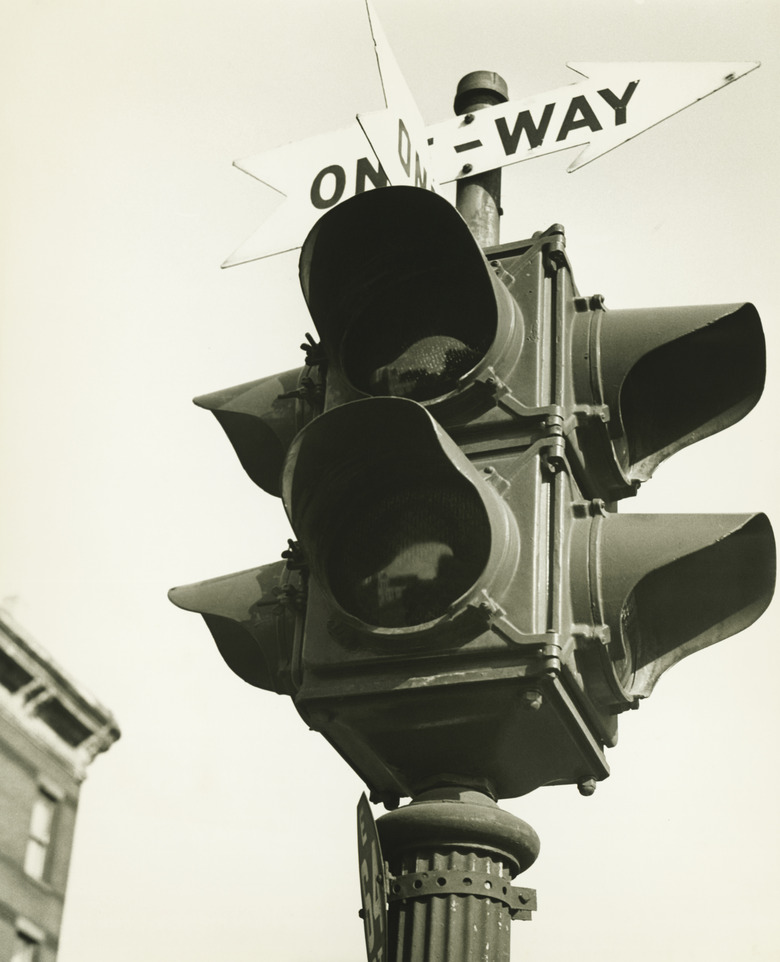Invention Of The First Traffic Light
Prior to the invention of traffic lights, horseback riders, horse-drawn carriages, bicycles and pedestrians competed for the right of way on roadways with limited guidance beyond courtesy and common law. When the automobile came along, it became obvious that some type of organization was needed to control the often chaotic flow of traffic. England is credited with inventing the first manually-operated traffic light, while electric traffic lights evolved in the United States.
First Come, First Served
First Come, First Served
Before the invention of traffic signals, the rules of the road were based on mutual forbearance, or cooperation among those occupying the roadway. At intersections, people were generally expected to allow those who arrived at the intersection before them to proceed first. This soon became common law, but no one oversaw adherence to the law. A rule originating in France at the turn of the century giving a driver on the right the right of way was adopted throughout the United States but often was found unworkable.
A Dangerous Signal
A Dangerous Signal
The first traffic light — combining a gas lamp and wooden semaphores — was erected outside the Houses of Parliament in England in 1868. Designed by J.P. Knight, a railroad signalling engineer, it was manually operated by a policeman. It consisted of a 22-foot pole with two semaphore arms that were raised 45 degrees to signal "caution" and raised horizontally to signal "stop". At night, a policeman lit two gas lamps located on top of the pole and flashed the red lamp for "stop" and the green lamp for "go." Policemen operating the traffic light blew a whistle when the signal was changing. When a gas lamp explosion severely injured a policeman, Knight's style of traffic light was abandoned.
Bulbs in a Birdhouse
Bulbs in a Birdhouse
In 1912, Lester Farnsworth Wire, the director of traffic safety in Salt Lake City, Utah, constructed a traffic light resembling a birdhouse with two holes on each side. Inside each hole was a light socket. Wire inserted one green bulb and one red bulb into the holes on each side of the box. He mounted the box on a pole in the middle of a busy intersection and connected the device to overhead trolley and power lines. He strung another wire from the box to a pole at a corner of the intersection. Police officers could control the lights with a switch on the corner pole. Since Wire didn't patent his birdhouse-style traffic light, his claim to inventing the first electric traffic light often is disputed.
Down to a System
Down to a System
In 1918, James Hoge patented an electric traffic light system he designed several years earlier. The system consisted of four pairs of red and green lights mounted on intersection corner poles and wired to a central control booth. A policeman inside the booth manually changed signals to control the flow of traffic. The system was installed in 1914 at the corners of Euclid Avenue and East 105th Street in Cleveland, Ohio. Hoge's traffic light is generally considered the first electric traffic light.
References
- History.com: This Day in History: First Electric Traffic Signal Installed
- University of California, Berkeley: Technology Transfer Program: From Waving Arms to LED's: A Brief History of Traffic Signals
- BikeWalk.org: Traffic Control: An Exercise in Self-Defeat; Kenneth Todd
- The Guardian: Notes and Queries: Who Invented Traffic Lights and Where Were the First Ones Situated?
- United States Access Board: Traffic Signal Controllers and APS Technology
- Standard-Examiner: Utah Celebrates World's First Stoplight's 100th Anniversary
Cite This Article
MLA
Turner, Laura Leddy. "Invention Of The First Traffic Light" sciencing.com, https://www.sciencing.com/invention-first-traffic-light-12955/. 24 April 2017.
APA
Turner, Laura Leddy. (2017, April 24). Invention Of The First Traffic Light. sciencing.com. Retrieved from https://www.sciencing.com/invention-first-traffic-light-12955/
Chicago
Turner, Laura Leddy. Invention Of The First Traffic Light last modified March 24, 2022. https://www.sciencing.com/invention-first-traffic-light-12955/
